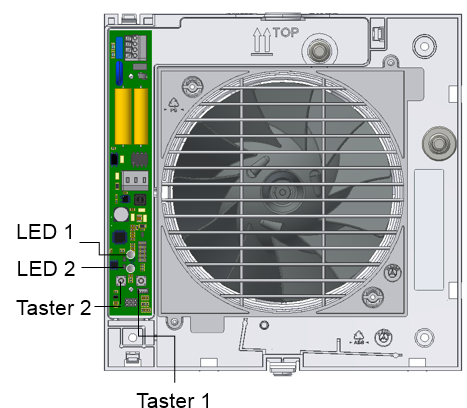Product information
The unit is a small room fan for dehumidifying rooms, especially cellars and other similar rooms. The unit has a fixed internal grille and is equipped with an integrated internal climate sensor. A controlled dehumidification takes place based on the comparison between the indoor climate and the outdoor climate. To do this, an external shutter with an integrated external climate sensor MUST be connected. To aid in the room dehumidification, an aeration fan can be directly controlled by the unit at the same time.
Function of the dehumidification control
The controlled ventilation dehumidifies the rooms (cellars) through targeted removal of humid room air and simultaneous supplying of dry outside air.
To do so, the absolute humidity (aH), as a measure for the water vapour content in the air, is determined by both climate sensors (those for interior and exterior spaces).
This measurement takes place immediately after switching on the unit. As soon as the absolute outside humidity falls below the absolute inside humidity (aHouter < aHinner) the unit’s fan is automatically activated and a dehumidification period begins (active time).
Ventilation and air extraction take place for roughly 10 minutes. Then the fan is switched off for a further 10 minutes so that the moist room air can mix with the dry air brought in from outside (passive time). After the waiting period has lapsed, the comparison of the inside and outside humidity is repeated.
If the absolute humidity of the outside air is found to be greater than that of the air inside the room (aHouter > aHinner), air is not exchanged. This prevents moist air from flowing in. The fan is only switched on again once the climate conditions make dehumidification possible.

Button 1 | Reference value determination |
Button 2 | Manual ventilation |
LED 1 | Operating mode |
LED 2 | Fan status |
Display | Function |
|---|---|
LED 1: On | Automatic operating mode |
LED 1: Blinking* | Manual ventilation |
LED 1: Blinks twice with long pause | Frost protection |
LED 1: Blinks three times with long pause | Protection against insufficient humidity |
LED 2: On (in automatic operation) | Active time during dehumidification (Fan on) |
LED 2: Off | Passive time during dehumidification (Fan off) |
LED 2: Blinking* | Successful dehumidification achieved (resettable with button 1) |
* Simultaneous blinking:
Simultaneous blinking of LED 1 or LED 2 indicates an operating mode or function. If both LEDs blink simultaneously, there is a fault, see Fault rectification.
Successful dehumidification – Button 1 / Blinking LED 2:
In the case that the room humidity is reduced by at least 0.2 g/m³, in comparison to the reference value, the unit signals successful dehumidification by LED 2 blinking. A reference value of 9 g/m³ is set on-site. A new reference value can be set at any time by pushing button 1 during ongoing operation. Saving of the new reference value is confirmed by LED 2 blinking briefly.
Frost protection:
To prevent the room from cooling down, the unit has a frost protection function. This means that the fan automatically switches off at inside room temperatures of less than 5°C.
Protection against insufficient humidity:
In the interest of health protection and energy efficiency, the unit offers a function which protects against insufficient humidity. This protective function ensures the switching off of the fan if a relative humidity of less than 30% is reached.
Manual ventilation – Button 2:
The unit switches the fan on and off automatically and in a manner optimised to demand. When off, the fan can be switched on manually with button 2 and manual ventilation therefore takes place. Manual operation is ended by again pressing button 2 or automatically after approximately 20 minutes.
Optionally, manual operation can take place with an external button, see Wiring diagrams. The fan cannot be switched off manually using the button when in the automatic operating mode.
Manual ventilation – external button/switch:
Optionally to button 2, manual operation can take place with an external button or switch, see Wiring diagrams.
To achieve this, an automatic button/switch recognition via the duration of the first activation after power is supplied. A switch is recognised when the switching contact is closed for more than 10 seconds.
Manual ventilation with an external button is equivalent to using button 2.
If an external switch is connected, manual ventilation is switched on or off in accordance with the switch setting. An automatic switch-off of the manual operating mode does not exist in this case.
 Damage to the building fabric due to manual ventilation
Damage to the building fabric due to manual ventilation
Excess manual ventilation can lead to room humidification if the outdoor conditions are humid. Therefore, you must pay attention to the duration of the manual ventilation when using an external switch.
 Manual ventilation is also possible during frost protection and protection against insufficient humidity.
Manual ventilation is also possible during frost protection and protection against insufficient humidity.